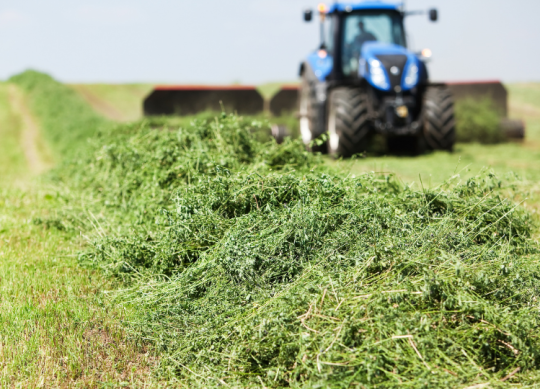9 Tips for Creating High-Quality Haylage
Legumes and grasses pose unique challenges when fermenting to become a high-quality haylage. Understanding the conversion of the hay crops into a high-quality fermented feed requires attention to a variety of management factors.
- Some of the management factors to be considered when creating a high-quality haylage include:
Harvest at the correct stage of maturity. Harvest legumes at the mid- to late-bud stage, and grasses at stem elongation or boot stages of maturity. Harvesting at earlier stages of maturity can result in significant reduction in yield and stand longevity, while harvesting too mature of forage reduces nutrient concentration and may pose packing challenges. - Harvest at the correct moisture. Make sure the moisture content is correct for the type of structure you are storing the haylage in. Suggested moisture targets are 55 – 65% moisture for bunkers and bags and 50 – 60% for tower silos. Excessive moisture can result in seepage and potentially a clostridia-type fermentation producing high levels of butyrate. Dry forages can result in less than desired packing densities with air trapped in the feed to foster yeast and mold growth.
- Chop to the correct particle length. At the targeted moisture ranges discussed above, aim for a theoretical particle length of ½ – ¾”. A longer particle length may be possible with wetter forages, and a shorter chop length may be necessary with drier forages to obtain a desirable packing density.
- Use the proper inoculant. Research suggests that proper inoculation with lactic acid-producing bacteria can foster a rapid increase in lactic acid production to decrease pH and preserve dry matter and nutrients. Specially selected Lactobacillus lactis bacteria have reduced clostridia-type fermentations with very wet forage under research conditions. The adage, “whichever side gets there first with most wins” certainly applies to the contest between native bacteria, yeasts and molds residing on the forage and the introduced, inoculating bacteria to encourage a proper fermentation.
- Size storage structure correctly. Consider the forage density per ft3, the square feet of exposed haylage face and then the forage needed per day. Haylage removal should be 6” or more per day to reduce spoilage.
- Fill the haylage structure rapidly. Minimizing the time period between initiation of filling and sealing of the bunker, bag or tower silo reduces dry matter and nutrient losses, as well as reduces the potential layers of spoilage due to breaks in filling the storage structure.
- Pack Properly. Proper packing reduces the air trapped in the forage which would otherwise foster yeast and mold growth. A good packing guideline is to provide 800 pounds of packing weight for every ton of forage delivered per hour. Therefore, if you harvest 100 ton per hour, you need 80,000 pounds of packing weight on the silo 100% of the time the feed is being delivered. Increased packing density allows greater forage storage in the same structure, as well as enhances dry matter and nutrient retention and facilitates better face management as the haylage is fed out. The forage density should be 16 pounds dry matter per ft3 or more.
- Properly seal the forage. A proper seal will exclude oxygen to discourage yeast and mold growth, while at the same time providing an ideal environment for the lactic acid-producing bacteria. In addition, a proper seal will protect the forage from rainfall and sunlight. Plastic improperly weighted down may flap in the wind and actually draw oxygen into the forage. Oxygen-limiting barriers and proper tire-to-tire contact on the plastic can achieve significant returns on investment through dry matter and nutrient retention, as well as reducing the outer layer of spoiled, moldy haylage to be removed before feeding.
- Proper feed-out management. In addition to the removal of 6” or more of haylage face daily to reduce forage spoilage, care should be taken to reduce excessive feed lifting which could result in cracks allowing air to enter the forage remaining in the storage structure. Loose forage remaining on the ground at the haylage face should also be minimized to reduce yeast and mold growth. Remember anytime that air is introduced into the haylage, yeast and mold growth will occur causing heating, protein destruction and the loss of dry matter and nutrients.



